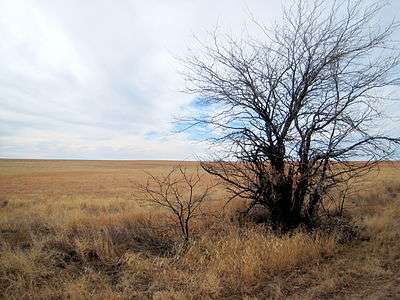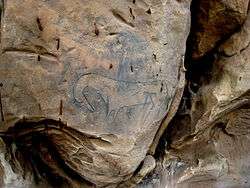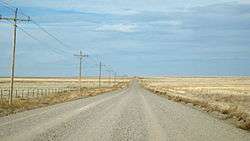Comanche National Grasslands
The Comanche National Grasslands are in the southeasternmost part of Colorado's Eastern Plains.

Understand
Colorado's National Grasslands are far off the beaten tourist track, usually not even on most travellers' lists of places to see. But for all that, the Comanche National Grassland has a lot to offer for wilderness backpacking, camping, and horseback-riding enthusiasts. There are a handful of great, well-marked canyon hikes, in addition to virtually limitless possibilities for off-the-trail wandering through the prairie.
Perhaps the number one reason to visit is for the sense of real isolation the grasslands offer. Anywhere else you go in Colorado, you'll be sharing the hiking trails with fellow travelers, but the grasslands offer memorable hikes where you can see in all directions straight to the horizon, with not a single sign of civilization visible.
The Comanche National Grassland is split into two main units, the Timpas Unit in the northwest, and the Carrizo Unit in the southeast along the Oklahoma border.
History

The first visitors to really leave their mark did so in the Jurassic Era. The Picketwire Canyon trail boasts the Purgatoire River dinosaur tracksite, the largest assemblage of dinosaur trackways in North America, which you can hike along (or in) for a long stretch of the trail.
But the Grasslands get their name from the Comanche Indians, who (along with the Arapaho and Kiowa peoples) lived and hunted in these parts before settlement by Europeans. The story of the Comanche Grasslands' inhabitants is older than these names, however, and it is written all over the canyon walls in the form of petroglyphs (in Picture Canyon, Carrizo Canyon, and Vogel Canyon) and the remains of prehistoric rock shelters (in Vogel Canyon). Not to be outdone by their prehistoric forebears, modern Americans have left their marks as well—wherever there is prehistoric art, you can expect that an appalling quantity of moronic name-scribbling will mar the visual experience. Oh well. Back to the history, though, the most intriguing prehistoric artifacts in Comanche adorn the walls of Crack Cave: rock carvings and glyphs that suggest astrological significance.
Early settlers rolled through a section of the Timpas Unit on the Santa Fe Trail. There's a marked 3-mile hike along the trail, where you can still see some old wagon ruts, by the Timpas Picnic Area. If you have a strong interest in the trail, definitely take a drive north to visit Bent's Old Fort National Historic Site up by La Junta.
Landscape
Grassland conjures up the image of endless seas of unbroken, flat prairie, with rarely an antelope to break the 360° panoramas of the earth's curvature. The Comanche offers plenty such landscapes, but that's not all there is to see. Big canyons cut across the Colorado southeast, especially near the New Mexican border. The popular canyon hikes run by interesting collections of mesas, spires, and hoodoo, with plenty of rock scrambling and even rock face climbing opportunities.
Flora and fauna
The principle game animals on Comanche include elk, mule deer, pronghorn antelope, dove, quail, and turkey. Bird watchers have about 235 species to look for. Threatened species include the burrowing owl, massasauga, northern harrier, ferruginous hawk, mountain plover, long-billed curlew, loggerhead shrike, grasshopper sparrow, swift fox, black-tailed prairie dog, plains leopard frog, whooping crane, and the American bald eagle. And watch your step for rattlers!
Sensitive flora species include the Andean prairie clover, Colorado Springs evening-primrose, Colorado frasera, Raven Ridge false goldenweed, sandhill goosefoot, and wheel milkweed. Prickly pear and cholla cactus are all over the place, so watch where you're going and consider wearing tough foot and leg wear.
Climate
Because this area has sandy land and dry air, people are advised to have plenty of water with them at all times.
Get in

It's hard to imagine anyone arriving to the Comanche National Grassland in any form of transport other than a personal car, which will also be pretty necessary to get around to the various trailheads. The main route from Denver takes you through La Junta to the lonely and beautiful route CO-109 South. From Trinidad or New Mexico, take CO-160 east, which will cut through the bottom portion of Comanche. From the Texas Panhandle and Oklahoma panhandles, take 287/385 north from Boise City.
Do not forget to load up on gas before coming out here! There are almost no commercial gas stations in the area (Springfield is probably the only option), and it is not unreasonable to expect go through more than a full tank of gas on a Comanche trip. Bringing spare gas is a basic safety measure.
Fees and permits
There are not a lot of fees or permits required out in these parts. Despite this, however, the camping sites and hiking trails are clean and remarkably well looked after. No admissions, no camping fees.
Get around
The dirt roads throughout Comanche are surprisingly well maintained, and should be perfectly accessible to low-clearance vehicles. You could get stuck in the mud during rain, though—it's a good idea to bring a shovel in your trunk just in case. The roads are unbelievably well marked with road signs too, so if you have good directions, you should be able to find your destination.
It's definitely worthwhile, in any case, to get an official grasslands map before heading out. The Grasslands are not solid blocks of territory, they are patchworks of public lands interspersed with private ranchlands, and it is best to stay aware of your location to avoid wandering on to someone's property. The official map is incredibly detailed, down to every last windmill and abandoned shack (although it stupidly leaves off the county road names), and is available for $10 from the US National Forest Store.
The canyon hikes are all well marked, so you shouldn't worry too much about getting lost on the trail, but if you plan to do serious off the trail wandering, a GPS (plus the official map) is a good idea. The grasslands can suddenly seem endless and they really are empty—you definitely will not run into people whom you can ask for directions.
See
Comanche isn't so much a sight-seeing destination, and the few "attractions" are right on the main hikes. Some of the most interesting things to see include the long set of dinosaur tracks on the Picket Canyon trail and the (sadly defaced) prehistoric rock drawings along the Picture Canyon and Vogel trails. Perhaps the most interesting attraction is Crack Cave, a small cave off the Picture Canyon trail full of prehistoric rock drawings and carvings of possible astronomical significance. But Crack Cave is fully sealed off unless you are on a guided tour during the equinox in March or September (call ahead for details).
Do

Carrizo trails
- Carrizo Canyon.
- Picture Canyon.
Timpas trails
- Apishapa Canyon.
- Picketwire Canyon (Withers Canyon).
- Vogel Canyon.
- Sierra Vista Trail.
- Withers Canyon.
Buy
Eat
There is a tiny town or two around Comanche, and while most meals will probably be ones you pack in your car, you can get a great hot meal in Pritchett.
- Pritchett Cafe (Right on CO-160/Randolph St). A small cowboy cafe in a small grain elevator town in the middle of the Carrizo Unit. Burgers and steaks dominate the short menu, freedom fries provide the patriotism, and the pies are fantastic. A friendly little spot. Next door is a small gift shop. $3-10.
Drink
- Campo Cafe. M-Sa. Campo Cafe is a great place for breakfast and lunch. Not open for dinner and closed on Sunday. There is also a BBQ place next door open at nights Th-Sa nights.
Sleep
There are definitely no hotels in the Comanche. The nearest places to stay are in La Junta and Springfield, although there are many more options back by Highway 25, near Trinidad for example.
If you're bringing an RV, be prepared to park it in the Springfield RV campsite, as there are no RV facilities anywhere else in the area.
Primitive camping is the number one option in the Comanche, and technically, you can pitch a tent anywhere on the National Grasslands except for Picketwire Canyon, which is protected. If you are hiking Picketwire, you may camp by the trailhead. Otherwise, it's best to camp relatively near a trail, since this section of the state is an often unpredictable patchwork of National Grasslands and private ranchlands. Ranchers might not take too kindly to squatters. The primitive campsite by the trailhead for Picture Canyon is a tribute to the US Forest Service—clean, excellent (albeit very primitive) facilities for tent campers in a quiet and relatively sheltered section of canyon.